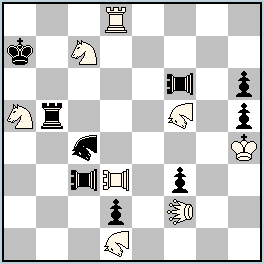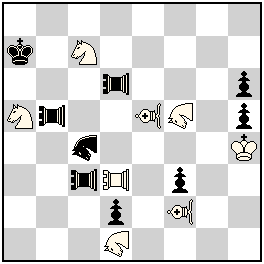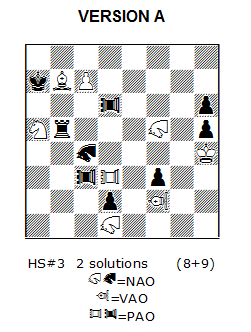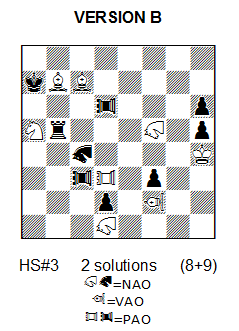| No.460, 460.1 Georgy Evseev (Russia) |
Original Problems, Julia’s Fairies – 2013 (III): September- December ?Previous ; ?Next ; ?List 2013(III) Please send your original fairy problems to: julia@juliasfairies.com |
No.460 by Georgy Evseev – A non-standard Chinese strategy! (JV)
No.460.1 by Georgy Evseev – An improvement to No.460 shown in author’s comment and announced as a final version! (JV)
Definitions:
NAO(NA): (1,2) Chinese piece, operating along the lines of Nightrider. Moves without capture like Nightrider, captures only by hopping over a hurdle to any square beyond.
PAO(PA): (0,1) Chinese piece, operating along the lines of Rook. Moves without capture like Rook, captures only by hopping over a hurdle to any square beyond.
LEO(LE): (0,1)+(1,1) Chinese piece, operating along the lines of Queen. Moves without capture like Queen, captures only by hopping over a hurdle to any square beyond.
VAO(VA): (1,1) Chinese. Chinese piece operating along Bishop lines. Moves without capture like Bishop, captures only by hopping over a hurdle to any square beyond.
|
No.460 Georgy Evseev
Russia
original-23.12.2013
 hs#3 2 solutions (8+9)
NAOs: d1, f5, c4 PAOs: c3, f6 LEO f2 Solutions: (click to show/hide)
|
No.460.1 Georgy Evseev
Russia
Version to No.460 -13.01.2014
 hs#3 2 solutions (8+9)
NAOs: d1, f5, c4 PAOs: b5, c3, d6 VAOs: e5, f2 Solutions: (click to show/hide)
|



Just wonderful!
Critical play by the wNAf5/wPAd3 (critical square d4) and bPAf6/bNAc4 (critical square b6). In the first solution the wNAf5 must finish on h6, and in the second solution the wPAd3 must finish on d2, but those squares are occupied by black pawns, so the wNA/wPA use each other as hurdles so they can capture on those squares! The bPAf6/bNAc4 take turns “locking-in” (incarcerating) the other, so that on B3 Black only has one move (White’s final move is not a check).
The pinned black pieces on b5 and c3 guard squares in the wK’s field. Note that in the second solution White must play 1.PAd3-d5, because 1.PAd3-d7+? would check the bK and 1.PAd3-d6? would prevent 2…PAf6-b6.
The thematic scheme and play are perfect and beautiful.
A correct realization of a complex scheme brings technical difficulties and questions about the acceptable compromises in the economy.
Helpselfmate appears as a paradise of freedom compared to helpmate, particularly when the white economy is analysed.
One thing which certainly spoils my impression of this perfection is completely superfluous wSc7 in one phase. Actually, wR is superfluous, instead of Rd8, wSd7 would do the job and wSc7 would be needed to guard either a8 or a6. 3rd wS (a5) guards b7 and closes a-file. wPa5+bPb7 could do these jobs, instead.
I might guess that Georgy had that in mind, but preferred to provoke people like me 🙂
Well, Nikola, when I saw this beautiful problem for the first time my first reaction was that wQc8 (+wPa5,c7) can be used instead of wRd8, wSa5 and Sc7. But obviously the author prefere to have white pawnless position. It’s a matter of taste.
‘a5’ has to be blocked in the first solution and “c7” has to be blocked in the second sol. for the mutual incarceration to work. It is ideal to leave b6 unguarded (rather than have white pawn a5). So I go with the present construction.
Superfluous white piece tastes disgusting and “pawnless” tastes rather irrelevant to me. Of course, everyone should eat what tastes good to him. Cheers!
Excellent and unexpected zz finish! Great idea of mutual incarceration. I like it very much despite the underused WSc7 !
Diyan,
Your opinion is the nearest to my own one. I also especially like when a piece has several different functions. Sc7 controls square a6, blocks NAa8 and prevents 1.Pad7. it is just bad luck)) that all these functions are needed in the same solution, but I can live with it. (In reality I am more uneasy that I had to put Leo on f2 to avoid cooks, while Vao would have been enough thematically).
Also, I am still thinking that the author should be allowed some freedom of white force use in helpselfmate, as black are the mating side.
-“…the author should be allowed some freedom of white force use in helpselfmate, as black are the mating side”-
I am actually frightened with such reasoning, where it will lead us if we ignore the origin and causes of the commonly accepted values?
The material should be OPTIMAL=only enough sufficient to fulfill the task and achieve the thematic content. White and Black cooperate for n-1 moves, in that part both W&B economy looks equally important. But in the final s#1, it’s WHITE who FORCES Black to mate. White n-th move is the cause and black n-th move is an automatic and unavoidable result. White can and must choose n-th move precisely. The fact that Black mates is irrelevant in the end, everything needed for the mate must be already prepared during n-1 moves and finalized with the last white move. Therefore, white economy is still primary. Cooks and duals should be prevented by black material, in principle.
It appears as that for selfmates there is some consistent logic saying that black economy is primary. I would like to learn and understand it (the mere fact that Black mates is essentially irrelevant for the logic of causes and results, since the choice of the play has disappeared).
Nicola,
I am taking some time to answer you. Do not want to be too hasty and then start taking my words back.
Compare this play with the original solution I.:
White LEb7 Pd7 Sa6 NAf6 Kh5 Pe2 (6)
Black Ka8 PAg7 Ph6 Rb4 PAe4 PAf3 Pg3 (7)
hs#6
bPAOs e4, f3, g7
wNAO f6
wLEO b7
1.d7-d8=NA Rb4-b6 2.NAd8-b4 PAe4-c4 3.NAf6-d2 PAf3-f7 4.LEb7-g2 PAf7-a7 5.e2-e4+ PAg7-b7 6.NAb4-h7 PAa7*h7#
Bristol, Umnov, fairy promotion, pin, self-pin, blockade, anti-batteries, opening and closing of the lines.
Nikola,
1. Generally in helpplay problems (and helpselfmate is a helpplay genre) both sides are working together for reaching the same goal and as such we should have been applied mainly the same criteria to both sides.
2. The only difference is in the final. I see here some distinction in our approaches: while I consider as “final” the resulting mating position, you tend to emphasize the position before the mating move. While where is no implicit logic requirement to choose one or another, I still consider the mating position is more significant as the “end of solution”.
3. Of course, it is better to have all pieces used in play, but we are speaking about situations when we have necessity or author’s will to do otherwise. In this case there is no real reason to prefer black over white (or vice versa) at a halfmove before mate and there are obvious economy reasons to avoid unneeded black in mating position.
4. There are also two traditions which are often taken for granted but not really well justified, especially in helpplay. The first one is the economy of white material. There is an obvious reason for economy of white material in direct mates. We also see the economy of black in selfmates (especially in the earlier ones) and the economy of white in helpmates. In both latter cases the reason is the quality of mating position – the same reason I cite in the helpselfmate case.
The second one is the disparaging attitude to pawns. They are quite often viewed as “building bricks” which may be used without restriction for technical purposes. While in general this is another kind of “necessary evil”, I think that the author has the right to choose between white piece and white pawn if one or another is needed anyway.
Many years ago there was a discussion in USSR concerning the following problem (IIRC) – http://www.yacpdb.org/?id=37889. Here white knight f7 has no role in the solution and it may be replaced with a pawn f4. Still the result of discussion was that the use of knight is justified enough.
ABOUT No. 460 ЕVSEEV [/img]
[/img]
After so many comments, I would like to say my opinion: № 460 has an excellent thematic scheme but the technical realization is not good and I personally consider this problem as an unfinished work for two obvious reasons:
a) In the first solution: I. 1.NAf5-b3 PAf6-a6 2.PAd3-d4 + NAc4-b6 3.NAb3xh6 PAa6xh6 # the w.Sc7 is completely superfluous piece. In my opinion (expressed in many of my articles!), such figures in the HS# genre are aesthetically completely unacceptable. But there are also other views, of course. Each author can compose his own way!
b) The bad white piece LEf2 which can’t be replaced here with a VAO, because of cooks of the following type: 1.VAg1 NAa3 2.PAd6 NAb1 3.NAfe3+ f2# etc. Here the most powerfull Chinese piece on the board – LEO is stationary: it plays two different roles – pined a black figure on b6 (a very nice motive), and prevents a banal cook.
These two negative factors cited in a) and b), made my opinion that the problem is an unfinished work.
In such cases, the most natural first reaction of the author should be to look for a ways to avoid the weaknesses. It is true that such efforts are not always successful. But it is also true that very often it turns out that the initial version can be fixed in one way or another.
Therefore, in my opinion, the author shouldn’t quickly justify the weaknesses in his problem with dubious or debatable motives.
In fact, the task of Evseev can be corrected with a few simple tricks construction – they remove all weaknesses:
I only show two versions:
[img
The solutions are the same:
I. 1.NAf5-b3 PAf6-a6 2.PAd3-d4 + NAc4-b6 3.NAb3xh6 PAa6xh6 #
II. 1.PAd3-d5 NAc4-a8 2.NAf5-d4 + PAf6-b6 3.PAd5xd2 NAa8xd2 #
[img [/img]
[/img]
It is possible to choose any of these versions! For example, in version A instead of white Bc7 we have white Pc7. Formally, it is more economical. But here (as in Evseev`s problem) the square “b6” is free. Therefore: here solver must consider for what purpose and how to save (or block) this field. Due to the limited white material, these goals probably seems easier to detect.
On the contrary – in the version В the black King have no free squares and here it is rather difficult to find the idea of the author. For this reason I would prefer the version B! But it’s also a matter of personal choice.
In his last comment Georgy noted: “Many years ago there was a discussion in USSR concerning the following problem (IIRC) – http://www.yacpdb.org/?id=37889. Here white knight f7 has no role in the solution and it may be replaced with a pawn f4. Still the result of discussion was that the use of knight is justified enough”.
Please look at the problem that Georgy cites. Here the Sf7 is quite a superfluous piece and in my opinion all attempts to justify this weakness are inconsistent. I am contemporary of discussion, mentioned by Georgy and I have known many of the participants in this discussion. According to my memories and notes of that time, the conclusions of that discussion regarding superfluous pieces were not so categorical as Georgy probably believes.
And a logical question: at present, how many modern orthodox #2 works of great masters you can see where the white figures do not play in the real solution? Of course, I’m not speaking about so called “Alphabetical problems” where any miracles are possible…
On the other hand, a discussion in one country between a limited number of composers can not produce the rule of a global importance! The question if in an orthodox problem the superfluous white pieces in the real play should be allowed is to be decided only by WFCC and recorded in the Codex! Such an approach is probably necessary also in HS# , etc.
Georgy, you say:
-“… I still consider the mating position is more significant as the “end of solution…”-
Stipulation states that among all possible plays, there is a unique play which fulfills the stipulation.
If all possible plays fulfill the stipulation, the stipulation is completely superfluous.
In #n,h#n,s#n,hs#n,r#n, (or series problems) stipulation is fulfilled with n-th white move. After n-th white move, the stipulation could be forgotten, it becomes completely irrelevant!
The mating black move is crucial for the stipulation in selfmates, in order to motivate the PARTICULAR CHOICE of the play which will arrange the mates.
A chess problem is the choice of the particular play, but this choice ends with white n-th move.
Whatever might be the esthetic and thematic features of the very mate to wK , they must be arranged BEFORE the mating move.
In hs# particularly, all possible specifics of the mating move are definitely determined with white n-th move. Ideal mates, pin mates, battery double-checkmates, cross-checkmates…, nothing depends on Black in his last move.
I perfectly agree with:
-“… there are obvious economy reasons to avoid unneeded black in mating position “-
But that comes AFTER the unneeded WHITE pieces are avoided. Especially the white pieces which are completely unneeded in one whole phase.
Nikola,
You wrote that A chess problem is the choice of the particular play, but this is not the only thing that creates aestetic impression. The arrangment of the mating features is often secondary in comparison to mating position itself, as in the painting when we first consider the end result and then possibly the artist’s work that lead to it.
Also, you have ignored my main statement: in helpplay problems there is no real difference between black and white except the mating position. So, before the mating position white and black really should have exactly the same rights.
The legacy of direct mates (leading role of white) is inapplicable here and cannot be taken into account.
—
Also, this problem was composed some time ago and after this discussion I have consulted my old records. It looks that I very much wanted to keep as much freedom for white Pao as possible giving it some choice of play (unfortunately, the board is not big enough to provide similar choice for Nao).
As nobody else thinks that this is that significant, I would like to replace initial position with following version based on those records (with Vaos and without Rooks and Leo):
[img]http://www.yacpdb.org/xfen/?8/k1N5/3(r3)3p/N(r3)2(B3)(N3)1p/2(n3)4K/2(r3)(R3)1p2/3p1(B3)2/3(N3)4[/img]
I will still miss the moves 1.PAd6? and 1.PAd7? though…
Georgy,
concerning this GOOD version, I repeat the last sentence from my first post:
-“I might guess that Georgy had that in mind, but preferred to provoke people like me :-)”-
Concerning the discussion about the basic principles, there’s a question of the GENERAL principles and the SPECIFIC principles in the SPECIFIC cases.
The original LOGICAL BASIS of the general principles might allow some alterations and exceptions in specific cases.
But the specific principles should not be carelessly accepted as general.
Black mating move in (h)s# might have some specific feature (e.g. model mate) which demands a proper black economy. Ideal mate would demand a proper white economy as well.
If a “special” mate is the main or only content of a particular (h)s#, then the whole play is constructed to achieve that “special” mate. But the possible “specific” principles are established only for the “special-mate” problems.
Generally, it is the complexity of a play which makes the original content of (h)s#. “Special principles” for “special mates” should be forgotten and “general principles” applied.
The essence of any problem is fulfilling the task. The final result is given (stipulated) in advance. The fulfillment of a task is a precise action which makes the GIVEN RESULT inevitable.
It is not easy for me to formulate shortly the roots of the logic. You should search for these roots yourself.
There are conventions which simplify the stipulation, so we can easily and precisely recognize it. We know by default what is expected from White and what from Black.
The convention is that always White fulfills the task and Black opposes or cooperates.
If a fulfillment of some task would always be considered as the mate, the s# would be defined as “Black forces White to mate bK”.
The logic roots of all problems and tasks naturally recognize the point when the task is fulfilled.
We should not neglect the roots just because we forgot them. Unfortunately, any arbitrary principles could be imposed by force, although the logic fails to support them.
As the carrier of the task is White, the priority of the art and skills is to use the minimal white force, in general principle.
The special principles should present the convincing special reasons.
What would be the special reasons for wSc7, wLEf2 and a poor static wRd8, guarding the single square?
The mates to wK certainly not. Are the tries 1.PAd6/d7? so valuable, especially since there’s no such try in the other phase?
Nikola,
You have written:
The convention is that always White fulfills the task and Black opposes or cooperates.
This statement looks like wordplay in helpplay genres. In fact both white and black are working to reach the same goal. There is no reason to prefer one over another except tradition which does not fit here.
Just for example, let’s define “helpforcedmate” where white begin and with the help of black mate them in required number of moves, but the mating move must be forced. According to your approach in this case we will again need white economy in the first place. But this “helpforcedmate” is exactly helpselfmate under another guise and by some wordplay we have overturned our “standard” economy requirements. Are you sure this is a way to go?
Whatever the wordplay might produce, in such “helpforcedmate” the essence would be that Blackc fulfills the task (and black economy would be required). This would belong to the inversed convention.
In a helpmate genre, White finalizes the task by mating bK. Since Black cooperates, the white force can be much more delicate than in direct problems. There’s no need to care about the potential black non-thematic defenses.
In hs#, White finalizes the task with a very special kind of PSEUDO-mate or PSEUDO-stalemate. The specialty is a unique half-move left to Black.
Because of the help-play, that pseudo-mate/stalemate should be achieved with a delicate white economy but that specialty, the additional forced black move, might allow some white extra-force. Since the potential black defenses occur only in that last half-move, there are not much reasons/excuses for too great white force.
The true benefit of hs# is that white force might be initially present on the diagram and sacrificed with much, much less troubles with cooks than in h#.
Georgy,
In my opinion your last version has an important weakness – the both black thematic pieces – PAd6 and NAc4 do not have adequate thematic functions. Pad6 includes VAe5 on the field b8, but in the play of NAc4 lacks such an element. For this reason, two solutions are not equivalent in thematic terms.
For example: in the solution II. 1.PAd3-d5 NAc4-a8 2.NAf5-d4 + PAf6-b6 3.PAd5xd2 NAa8xd2 # we have Bivalve theme after 2….PAf6-b6 (includes VAO, closes NAO) but such motives are absent in the another solution: I. 1.NAf5-b3 PAf6-a6 2.PAd3-d4 + NAc4-b6 3.NAb3xh6 PAa6xh6 # because NAc4 does not include a white figure!
Therefore, here VAe5 performs only a technical (artificial) function and as shows version “A” in my previous comment, this figure can be replaced even with a white pawn – with preserving of thematic equivalence of the both solutions.
Petko,
The effect of opening the line for white Vao exist in both solutions, together with similar effects of opening the lines for black Paos. This looks more like direct repetition of effect, than function change, so it is not a strong point of the problem, but I do not think that this is a weakness.
It is a small detail making formation of nets around the kings more complex without adding extra material.
Georgy, would you like me to publish some final version? I’m not sure if it still can be related to period JF-2013/III. I need judges’ opinions here as well. If you think some further improvements are possible and more time is needed, I can exclude the published problem from the tournament JF-2013/III and your improved version can participate in JF-2014/I (or the next…).
Julia,
Please consider version from the message January 13, 2014 at 08:09 as final. It is up to you and/or the judge to decide which tournament it will be included in.